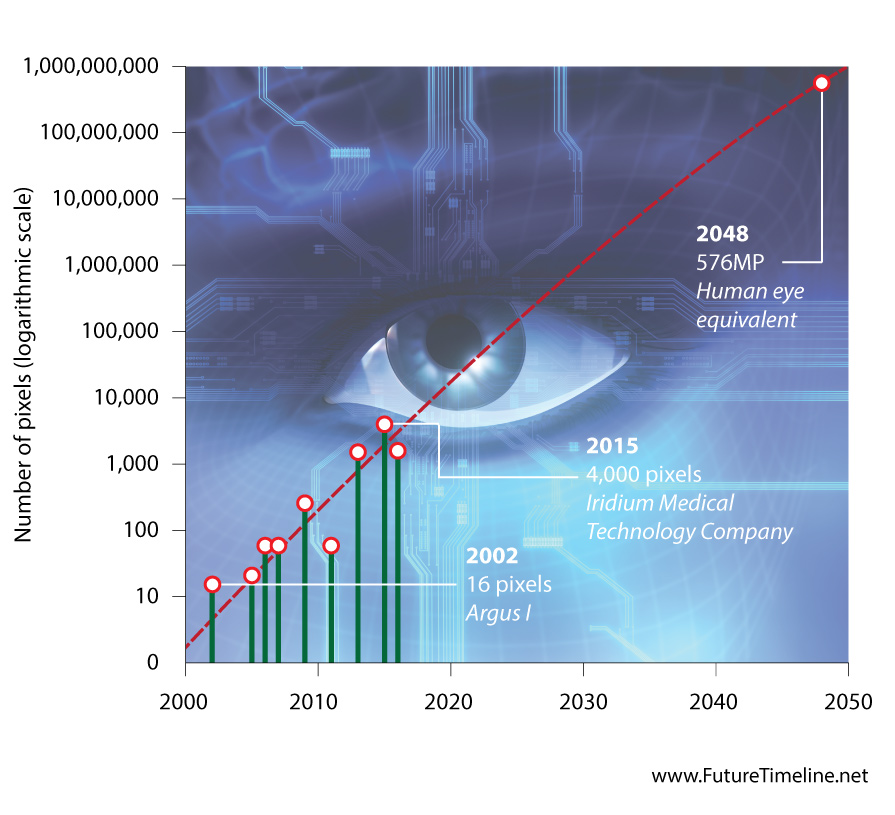
Bionic eye technology, 2000-2050 This graph shows the progress in bionic eye technology from 2000 to 2050. The y-axis indicates the number of pixels generated by electrode arrays for various artificial retinas and other visual prostheses, displayed on a logarithmic scale. In 2002, researchers developed an early bionic eye prototype known as the Argus I. Featuring just 16 electrodes, it provided only basic functionality that allowed blind patients to detect when lights were switched on or off, describe an object's motion, count discrete items, as well as locate and differentiate certain objects in their surrounding environment. A more advanced version, the Argus II, began clinical trials in 2007 and included 60 electrodes. In subsequent years, a number of companies began to substantially improve the available pixel resolution for eye implants, hinting at a possible emerging trend similar to Moore's Law and other "exponential" technologies. Iridium Medical Technology Company based in Hsinchu City, Taiwan, has created a retinal prosthesis that generates 4,000 pixels. According to their product description, that is sufficient to enable patients "to recognise faces and objects, read big-print books, and navigate easily through life." Ongoing, exponential progress has the potential to revolutionise patient care. Future eye implants in the 2020s and 30s could provide smoother and more colourful visual qualities, as opposed to the monotone and blocky view of the world in current-generation devices. It may actually be possible to reach human eye quality, if the trend in pixel counts is maintained. Scientists have calculated that our eyes contain photoreceptors equivalent to a 576 megapixel (MP) digital camera. This resolution could be achieved by 2048, based on current projections indicated in the graph below. Further improvements may lead to superhuman vision in the 2050s and beyond. Even healthy people may then forego their natural eyes in favour of upgraded cyborg versions. With sufficiently miniaturised components, these future implants might include additional features, such as the ability to record video and capture every moment of a person's life.
Sources: Notes on the Resolution and Other Details of the Human Eye, ClarkVision.com: "Mark Humayun, MD, PhD, implanted six subjects with the first generation 16-electrode (Argus™ 16) between 2002 and 2004. The study demonstrated the ability of participants to detect when lights are on or off, describe an object's motion, count discrete items, as well as locate and differentiate basic objects in an environment." Visual Prostheses – Devices, Institute for Ophthalmic Research: Real-life Story of the 'Bionic Eye,' the Argus II, Retina Specialist: Wearable Computer Vision Systems for a Cortical Visual Prosthesis, The Computer Vision Foundation: Patents Assigned to IRIDIUM MEDICAL TECHNOLOGY CO, LTD., Justia Patents: "IMTC enables patients to recognize faces and objects, read big-print books (font size > 14 pt.), and navigate easily through life by using its 4,000-pixel device." Advances in retinal prosthesis systems, Therapeutic Advances in Ophthalmology: Seeing the future: the bionic eye, Australian Academy of Science:
Posted: 11th August 2019. Last updated: 11th August 2019.
If you enjoy our content, please consider sharing it:
|







